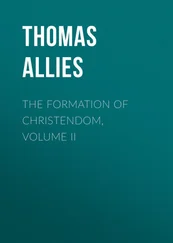Thomas Allies - Peter's Rock in Mohammed's Flood, from St. Gregory the Great to St. Leo III
Здесь есть возможность читать онлайн «Thomas Allies - Peter's Rock in Mohammed's Flood, from St. Gregory the Great to St. Leo III» — ознакомительный отрывок электронной книги совершенно бесплатно, а после прочтения отрывка купить полную версию. В некоторых случаях можно слушать аудио, скачать через торрент в формате fb2 и присутствует краткое содержание. Издательство: Иностранный паблик, Жанр: foreign_antique, foreign_prose, Историческая проза, на английском языке. Описание произведения, (предисловие) а так же отзывы посетителей доступны на портале библиотеки ЛибКат.
- Название:Peter's Rock in Mohammed's Flood, from St. Gregory the Great to St. Leo III
- Автор:
- Издательство:Иностранный паблик
- Жанр:
- Год:неизвестен
- ISBN:нет данных
- Рейтинг книги:4 / 5. Голосов: 1
-
Избранное:Добавить в избранное
- Отзывы:
-
Ваша оценка:
- 80
- 1
- 2
- 3
- 4
- 5
Peter's Rock in Mohammed's Flood, from St. Gregory the Great to St. Leo III: краткое содержание, описание и аннотация
Предлагаем к чтению аннотацию, описание, краткое содержание или предисловие (зависит от того, что написал сам автор книги «Peter's Rock in Mohammed's Flood, from St. Gregory the Great to St. Leo III»). Если вы не нашли необходимую информацию о книге — напишите в комментариях, мы постараемся отыскать её.
Peter's Rock in Mohammed's Flood, from St. Gregory the Great to St. Leo III — читать онлайн ознакомительный отрывок
Ниже представлен текст книги, разбитый по страницам. Система сохранения места последней прочитанной страницы, позволяет с удобством читать онлайн бесплатно книгу «Peter's Rock in Mohammed's Flood, from St. Gregory the Great to St. Leo III», без необходимости каждый раз заново искать на чём Вы остановились. Поставьте закладку, и сможете в любой момент перейти на страницу, на которой закончили чтение.
Интервал:
Закладка:
We have now to follow briefly one of the greatest revolutions which has ever occurred in human affairs. It is a revolution which not merely sets up one kingdom instead of another, or alters the persons of individual rulers; but which changes human society to its very depths, provides a different standard of morals, and, so far as it succeeds, but only so far, reverses the course of Christian civilisation, and undoes in certain countries the greatest conquests which the Christian Church had obtained for the good of the human race. Not States only are changed, but fathers and mothers, husbands and wives, sons and daughters: in fine, Græco-Roman heathenism has disappeared, but instead of it arises a religion borne on the shoulders of a temporal rule, and a legislation compared with which in certain respects that old heathenism was pure and benignant. The revolution reaches in fact man's belief in the nature of God Himself: and a change of belief in the nature of God involves a change in all His relations to His moral creatures, and in their relations to each other. The creature in all action reproduces what it holds concerning the Creator. The religion of self-sacrifice springs from a God who sacrifices Himself: the religion of self-indulgence from a God from whose worship sacrifice has been expunged.
It appears that even before the triumphal entry of Heraclius into Jerusalem with the recovered cross he had met in the Persian campaigns, in 622 or 623, with a certain bishop named Cyrus, then holding the see of Phasis, in Armenia. But Cyrus himself had for years before been in communication with Sergius, the powerful patriarch of Constantinople, the guide and inspirer of the emperor. Sergius had held the see of the capital since the year 610, in which the accession of Heraclius took place. It had been all along his dream to reconcile the various monophysite sects which troubled his master's empire. In the political point of view such a reconciliation could not but appear very important. In Egypt alone the Monophysites numbered about six millions, against three hundred thousand orthodox. How deeply their national feeling was mixed up with their heresy is shown by the name of Melchites or Royalists, which they gave to their opponents. The patriarch Sergius and the emperor Heraclius fell upon the device of gaining the heretical party, not only in Egypt, but in the Eastern empire generally, to at least an outward union with the orthodox by introducing the formula “One Operation” as a theological expression for the acts of our Lord. St. John of Damascus describes in his treatise on heresies the 99th as that of the Monothelites “who derived their origin from Cyrus of Alexandria, and their strength from Sergius of Constantinople. These men maintained two Natures in Christ, and one Person, but assert one Will and one Operation, by which they destroy the duality of natures, and strongly adhere to the doctrines of Apollinarius.” Now Sergius, uniting great ability and strong character to his position as bishop of the capital city and minister of the Emperor Heraclius, dominated his mind. Heraclius exerted himself greatly to disseminate the formulary of these two patriarchs. His purpose was that of drawing together his own distracted empire. This purpose of Heraclius is carried back so far at least as the year 628. Nay, at the beginning of his campaign against the Persians he recommended it. How much more when by the peace of the year 628 he recovered the provinces which had been taken from him. It would seem that the faltering of Heraclius in the faith, which he was willing to subject to a deceptive compromise the doctrine of the incarnation itself, was coincident in time with the opening of the Mohammedan era, the hegira or flight of Mohammed from Mecca, which marks his assumption of the claim to propagate by force a conquering religion. That claim was in a few years to cost Heraclius the half of his empire. It is certain that about the year 630 he promoted Cyrus to be patriarch of Alexandria. He also put a certain Athanasius of like doctrine into the see of Antioch, and thus three patriarchal sees at once were in favour of the heresy. And Sergius wrote to Pope Honorius commending it as a wonderful mode of restoring unity to the Church in the East.
Cyrus drew up nine heads of doctrine, by which he thought that he had reconciled the Theodosians and other powerful sects in Egypt. His announcement was received with exceeding joy by Sergius at Constantinople. Sergius wrote to Pope Honorius describing the action of Cyrus in these words: “Certain dogmatic heads were agreed upon between the two sides, in consequence of which those who but yesterday were parted into divisions and acknowledged the wicked Dioscorus and Severus as their ancestors, were united to the one most holy Catholic Church, and all the people of Alexandria, beloved by Christ, and besides this we may say all Egypt and Thebais and Libya, and the other dioceses of the Egyptian province, became one flock of Christ our true God. They who were until then to be seen an innumerable multitude of divided heresies, now, by the good pleasure of God and the zeal well-pleasing to Him of the most holy prelate of Alexandria, have all become one, with one voice and unity of spirit, confessing the true doctrines of the Church.”
Such was the picture set before Pope Honorius by the patriarch Sergius, then in the height of his credit as bishop of the imperial city and prime minister of the emperor, in the year 633, when Abu Bekr was elected the first of the chalifs to carry on the power of Mohammed, who had died a few months before. A few years after this supposed reunion of all, these same Egyptians welcomed submission to Omar, the second chalif and successor of Abu Bekr, as lord of Egypt, who would, as they thought, be more favourable to them than Heraclius.
And the successor of St. Peter was deceived into believing that the picture drawn by Sergius was a true statement.
But before the union described in such terms by Sergius had been completed, a man had come to Alexandria, who was to protest in the face of the whole world against this compromise to which the Catholic faith was being subjected. This was Sophronius, a monk of high repute, to whom the patriarch Cyrus showed the articles of union, while they were as yet unpublished. Sophronius threw himself at the patriarch's feet, and conjured him most earnestly not to announce them from the pulpit, as they manifestly expressed the heresy of Apollinaris. Sophronius did not succeed with Cyrus, but carried a letter from him to Sergius at Constantinople, to whom it would seem that Cyrus directed him as the chief supporter and exponent of the doctrine which Sophronius rejected.
All that Sophronius was able to obtain from Sergius was that both expressions concerning the action of our Lord, as God-man, that is, the One Operation, or the Two Operations, should be equally avoided. Sophronius on his return to Jerusalem, was elected patriarch, and as such, presently issued his synodical letter. This is almost the most important document in the whole Monothelite struggle: a great theological treatise, which embraces the Trinity and the Incarnation, and fully sets forth the doctrine of the Two Operations in Christ. Copies of it were sent to all the patriarchs. The copy sent to Sergius has come down to us among the acts of the 7th session of the 6th council. Out of the copy in the acts I will here quote some few of the very words in which the great champion of the faith states the doctrine. It is that which St. Leo defined at the Council of Chalcedon, for which Pope S. Martin offered his life in sacrifice, for which the Popes preceding and following him suffered trials and persecutions without end, which four successive patriarchs of Constantinople endeavoured to overthrow, and for their incessant quarrels over which, three eastern patriarchates, with their bishoprics, were delivered over as a prey to the hordes of the false prophet.
Читать дальшеИнтервал:
Закладка:
Похожие книги на «Peter's Rock in Mohammed's Flood, from St. Gregory the Great to St. Leo III»
Представляем Вашему вниманию похожие книги на «Peter's Rock in Mohammed's Flood, from St. Gregory the Great to St. Leo III» списком для выбора. Мы отобрали схожую по названию и смыслу литературу в надежде предоставить читателям больше вариантов отыскать новые, интересные, ещё непрочитанные произведения.
Обсуждение, отзывы о книге «Peter's Rock in Mohammed's Flood, from St. Gregory the Great to St. Leo III» и просто собственные мнения читателей. Оставьте ваши комментарии, напишите, что Вы думаете о произведении, его смысле или главных героях. Укажите что конкретно понравилось, а что нет, и почему Вы так считаете.












